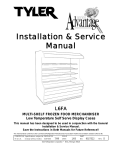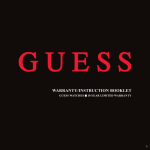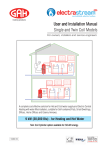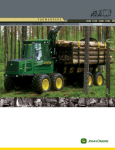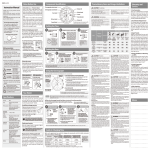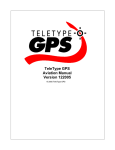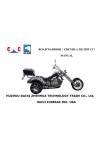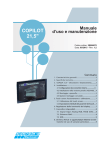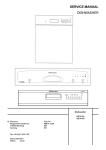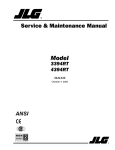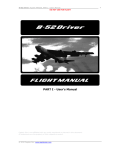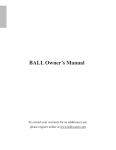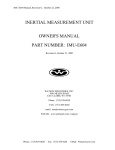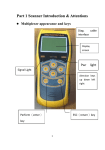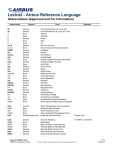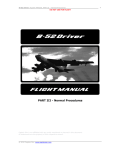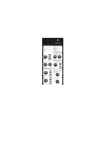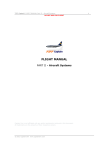Download Aircraft Systems
Transcript
‘B-52 Driver’ FLIGHT MANUAL Part II – Aircraft and Systems DO NOT USE FOR FLIGHT PART II – Aircraft and Systems Captain Sim is not affiliated with any entity mentioned or pictured in this document. All trademarks are the property of their respective owners. © 2010 Captain Sim www.captainsim.com 1 ‘B-52 Driver’ FLIGHT MANUAL Part II – Aircraft and Systems DO NOT USE FOR FLIGHT 2 ABOUT THIS MANUAL VERSION: 08 DECEMBER, 2010 WARNING: THIS MANUAL IS DESIGNED FOR MICROSOFT® FSX USE ONLY. DO NOT USE FOR FLIGHT. The ‘B-52 Driver FLIGHT MANUAL is organized into three Parts. Each Part is provided as a separate Acrobat® PDF document: • Part I – User’s Manual • Part II – Aircraft and Systems - this document. • Part III – Normal Procedures. FOR GENERAL INFORMATION ON THE ‘B-52 DRIVER’ PRODUCT PLEASE USE WWW.CAPTAINSIM.COM . THIS MANUAL PROVIDES ADDITIONAL INFORMATION ONLY, WHICH IS NOT AVAILABLE ON THE WEB SITE. © 2010 Captain Sim www.captainsim.com ‘B-52 Driver’ FLIGHT MANUAL Part II – Aircraft and Systems DO NOT USE FOR FLIGHT PART II – AIRCRAFT SYSTEMS Page 5 Contents INTRODUCTION 6 PANELS LAYOUT 7 11 11 12 12 12 13 13 13 14 15 16 17 17 17 18 18 18 19 19 19 20 20 20 21 21 21 21 22 22 22 23 24 24 25 26 27 27 27 27 28 28 28 28 29 29 29 29 30 30 30 31 31 31 31 PILOT’S INSTRUMENT PANELS 1. ANTI-ICE CONTROL PANEL 2. EVS CONTROL PANEL 3. CLOCK 4. FLIGHT COMMAND INDICATOR 5. ALTIMETER 8. MARKER BEACON LIGHT TEST SWITCH 9. INDICATED AIRSPEED INDICATOR 10. HORIZONTAL SITUATION INDICATOR 11. MARKER BEACON LIGHT 12. ATTITUDE-DIRECTOR INDICATOR TERRAIN AVOIDANCE RADAR SYSTEM CONTROLS AND INDICATORS 14. EVS MONITOR P20. TERRAIN DISPLAY CONTROL PANEL 15. VERTICAL VELOCITY INDICATOR 16. MACH INDICATOR 17. RADAR ALTIMETER 18. STANDBY HORIZONT INDICATOR 22. ENGINE PRESSURE RATIO GAGES 23. WING FLAP POSITION INDICATOR 24. LANDING GEAR POSITON INDICATORS PANEL 25. LOW OIL PRESSURE WARNING LIGHTS 27. ACCELEROMETER 29. MAGNETIC STANDBY COMPASS 30. EXHAUST GAS TEMPERATURE GAGE 31. FUEL FLOWMETERS 32. DME INDICATOR 34. OIL PRESSURE GAGES 35. TACHOMETERS 36. MASTER CAUTION LIGHT 38. FUEL SYSTEM MANAGEMENT PANELS 39. TOTAL FUEL FLOW INDICATOR 40. LANDING GEAR LEVER CROSSWIND CRAB SYSTEM TURNING ANGLES AVAILABLE WITH MAXIMUM CROSSWIND CRAB SETTINGS CONTROLS AND INDICATORS P21. CROSSWIND CRAB CONTROL KNOB P22. CROSSWIND CRAB CONTROL CENTERING BUTION 41. CROSSWIND CRAB POSITION INDICATOR 42. TOTAL FUEL QUANTITY INDICATOR 43. MAIN TANKS LOW WARNING LIGHT 44. SAS CONTROL PANEL 49. BOMB DOORS OPEN LIGHT 50. BOMB DOORS NOT LATCHED LIGHT 51. ANTISKID SWITCH 52. OUTSIDE AIR TEMPERATURE GAGE 53. BOMB DOORS SWITCH 54. RUDDER TRIM INDICATOR 55. AUTOPILOT TURN CONTROL SELECTOR SWITCH 57. WINDSHIELD WIPERS SWITCH 59. HEADING INDICATOR (GYRO) 60. TRUE AIRSPEED INDICATOR 62. MACH INDICATOR SWITCH 63. FLIGHT DIRECTOR SWITCH © 2010 Captain Sim www.captainsim.com 3 ‘B-52 Driver’ FLIGHT MANUAL Part II – Aircraft and Systems DO NOT USE FOR FLIGHT 32 33 33 34 34 34 OVERHEAD PANEL O01. OVERHEAD LIGHTING PANEL O03. UHF RADIO CONTROL PANEL O04. UHF2 RADIO CONTROL PANEL O05. TACAN RADIO CONTROL PANEL O06. VOR CONTROL PANEL 35 36 37 38 PILOT’S SIDE PANEL A01. HYDRAULIC PANEL A04. PILOT'S LIGHT CONTROL PANEL A07. ANTISKID MACH 39 40 41 41 42 42 43 COPILT’S SIDE PANEL B01. ELECTRICAL PANEL B02. TEMP INDICATOR B07. ENG START CONTROL PANEL B11. COPILOT'S LIGHT CONTROL PANEL B12. HF RADIO PANEL B14. BATTERY SWITCH PANEL 44 45 45 46 47 48 48 49 49 50 AISLE STAND P02. AIRBRAKE LEVER P03. AUTOPILOT TURN AND PITCH CONTROLLER P04. AUTOPILOT COMMAND SELECTOR PANEL P18. NAVIGATION SYSTEM SELECT PANEL P06. LANDING LIGHTS PANEL P10. STABILIZER TRIM WHEEL AND INDICATOR P11. THROTTLES P15. DRAG CHUTE LEVER P17. WING FLAP LEVER 51 51 51 51 CUSTOMER CARE FORUM VIDEO CHANNEL TECH SUPPORT © 2010 Captain Sim www.captainsim.com 4 ‘B-52 Driver’ FLIGHT MANUAL Part II – Aircraft and Systems DO NOT USE FOR FLIGHT 5 INTRODUCTION The 'B-52 Driver' is one of the most advanced, complete and accurate digital replicas of the B-52 aircraft ever available for any game platform. But the 'B-52 Driver' (same as MSFS itself and any MSFS expansion) is a flight simulation software game. Therefore this product should not be used as flight training device (FTD) and/or simulator for flight training purposes. Moreover the 'B-52 Driver' is Fun Line product, so it features some of essential systems programming. All items should work as described in this manual. If something is not described as functional (therefore it does not work or does not exist in the model) it is not a system 'bug' but a reasonable simplification. © 2010 Captain Sim www.captainsim.com ‘B-52 Driver’ FLIGHT MANUAL Part II – Aircraft and Systems DO NOT USE FOR FLIGHT PANELS LAYOUT 1. SLIDING WINDOW HANDLE 2. OVERHEAD PANEL 3. EYEBROW INSTRUMENT PANEL 4. COPILOT’S SIDE PANEL 6. AISLE STAND 7. PILOT’S INSTRUMENT PANEL 7A. ALTIMETER CORRECTION CARD AND HOLDER 8. PILOT’S SIDE PANEL © 2010 Captain Sim www.captainsim.com 6 ‘B-52 Driver’ FLIGHT MANUAL Part II – Aircraft and Systems DO NOT USE FOR FLIGHT PILOT’S INSTRUMENT PANELS LEFT © 2010 Captain Sim www.captainsim.com 7 ‘B-52 Driver’ FLIGHT MANUAL Part II – Aircraft and Systems DO NOT USE FOR FLIGHT CENTER © 2010 Captain Sim www.captainsim.com 8 ‘B-52 Driver’ FLIGHT MANUAL Part II – Aircraft and Systems DO NOT USE FOR FLIGHT RIGHT OVERHEAD © 2010 Captain Sim www.captainsim.com 9 ‘B-52 Driver’ FLIGHT MANUAL Part II – Aircraft and Systems DO NOT USE FOR FLIGHT 1. ANTI-ICE CONTROL PANEL 2. EVS CONTROL PANEL 3. CLOCK 4. FLIGHT COMMAND INDICATOR 5. ALTIMETER 8. MARKER BEACON LIGHT TEST SWITCH 9. INDICATED AIRSPEED INDICATOR 10. HORIZONTAL SITUATION INDICATOR 11. MARKER BEACON LIGHT 12. ATTITUDE-DIRECTOR INDICATOR 13. AUTOPILOT DISENGAGED LIGHT 14. EVS MONITOR 15. VERTICAL VELOCITY INDICATOR 16. MACH INDICATOR 17. RADAR ALTIMETER 18. STANDBY HORIZONT IND 19. RADAR ALTIMETER CAUTION LIGHT 22. ENGINE PRESSURE RATIO GAGES 23. WING FLAP POSITION INDICATOR 24. LANDING GEAR POSITON INDICATORS PANEL 25. LOW OIL PRESSURE WARNING LIGHTS 27. ACCELEROMETER 29. MAGNETIC STANDBY COMPASS 30. EXHAUST GAS TEMPERATURE GAGE 31. FUEL FLOWMETERS 32. DME INDICATOR 34. OIL PRESSURE GAGES 35. TACHOMETERS 36. MASTER CAUTION LIGHT 38. FUEL SYSTEM MANAGEMENT PANELS 39. TOTAL FUEL FLOW INDICATOR 40. LANDING GEAR LEVER 41. CROSSWIND CRAB POSITION INDICATOR 42. TOTAL FUEL QUANTITY INDICATOR 43. MAIN TANKS LOW WARNING LIGHT 44. SAS CONTROL PANEL 48. TOTAL OXYGEN QUANTITY GAGE 49. BOMB DOORS OPEN LIGHT 50. BOMB DOORS NOT LATCHED LIGHT 51. ANTISKID SWITCH 52. OUTSIDE AIR TEMPERATURE GAGE 53. BOMB DOORS SWITCH 54. LATERAL TRIM INDICATOR 55. AUTOPILOT TURN CONTROL SELECTOR SWITCH 57. WINDSHIELD WIPERS SWITCH 59. HEADING INDICATOR (GYRO) 60. TRUE AIRSPEED INDICATOR 61. LANDING GEAR CONTROLS PANEL 62. MACH INDICATOR SWITCH 63. FLIGHT DIRECTOR SWITCH © 2010 Captain Sim www.captainsim.com 10 ‘B-52 Driver’ FLIGHT MANUAL Part II – Aircraft and Systems DO NOT USE FOR FLIGHT 11 1. ANTI-ICE CONTROL PANEL 1,2. Pitot Heat Switches 3. Engine, Switch Nacelle, And Scoops Anti-Icing 1. Pitot Heat Switches Two ON-OFF pitot heat switches are located on the left side of the pilots' instrument panel. ON position of each switch energizes the I pitot tube heaters on the respective (left or right) side of the aircraft to prevent pitot tube stoppage by icing. The left pitot heat switch also controls the Q-spring ram air inlet heater. OFF position removes power from the heaters. 3. Engine, Nacelle, and Scoops Anti-Icing Switch The ON--OFF engine, nacelle, and scoops anti-icing switch on the anti-ice control panel controls anti-icing of engine inlet components, nacelle leading edge areas, the ram airscoop lip in the left wing, and the cabin emergency rain airscoop. ON position makes the connections to supply TR power to energize the various solenoids and relays which cause the anti-icing air valves to open and turn on the electrical heater power. OFF position deenergizes the solenoids and relays, causing engine, nacelle. and scoop anti-icing to be shut off. The emergency ram airscoop is electrically heated and will also cycle approximately 1 minute open and 15 seconds closed to prevent ice formation when the engine, nacelle, and scoops anti-Icing switch is ON and the air conditioning master switch is in RAM. 2. EVS CONTROL PANEL 1. Power Switch The power switch on the pilots' EVS control panel is a push-on/push- off type switch having an ON position (depressed) (switch face flush with switch housing) and an OFF position (extended) (switch face extends approximately 1/8 inch from switch housing) which is mechanically latched in each position. The switch is used to turn on and place the EVS monitor in standby mode. When depressed in ON position, the word "ON" green is illuminated on the switch face provided power is on in the aircraft. When the switch is pressed again and the switch face extends from its housing, the switch is OFF and the EVS monitor is deactivated and power is removed from the other circuits provided through the switch. © 2010 Captain Sim www.captainsim.com ‘B-52 Driver’ FLIGHT MANUAL Part II – Aircraft and Systems DO NOT USE FOR FLIGHT 12 3. CLOCK 1. Winding Knob 2,3. Hands 4. FLIGHT COMMAND INDICATOR The AN, ASQ-38(V) BNS flight command indicator (FCI) located on the pilots' instrument panel provides localizer information. 5. ALTIMETER 1.100-Foot Pointer 2. Barometric Scale 3. 100-Foot Drum 4. Barometric Pressure Set Knob 5. 1000-Foot Counter 6. 10,000-Foot Counter A type AAU-19/A altimeters on the pilot's and copilot's instrument panels. The altimeter has a counter-drumpointer display. Tne counters and drum provide a direct digital readout in hundreds and thousands of feet. The single pointer repeats the 100- foot indications of the drum, serving both as a vernier for the drum and as a quick indication of the rate and direction of altitude change. A barometric pressure set knob and barometric scale are provided for adjusting the altimeter setting. © 2010 Captain Sim www.captainsim.com ‘B-52 Driver’ FLIGHT MANUAL Part II – Aircraft and Systems DO NOT USE FOR FLIGHT 13 8. MARKER BEACON LIGHT TEST SWITCH Marker beacon indicator lights are tested by pushing the central caution panel test switch. 9. INDICATED AIRSPEED INDICATOR 1. Maximum Allowable Airspeed Indicator 2. Indicated Airspeed Pointer Located at both the left and right sides of the pilots' instrument panel. By the use of twо pointers, the pilots can observe the airspeed indication and the maximum allowable airspeed indication at the same time. The airspeed dial is graduated from 50 to 650 in 10-knot increments. 10. HORIZONTAL SITUATION INDICATOR 1. Range Indicator 2. Range Indicator Warning Flag 3. Heading Marker 4. Lubber Line 5. Compass Card 6. Course Deviation Indicator Warning Flag 7. Course Selector Window 8. Power Off Flag 9. Course Arrow (Head) 10. To-From Indicator 11. Course Deviation Indicator 12. Course Set Knob 13. Heading Set Knob 14. Course Arrow (Tail) 15. Aircraft Symbol 16. Course Deviation Scale 17. Bearing Pointer (head) 18. Bearing Pointer (tail) It is an electrically operated instrument and replaces the bearing distance indicator, the radio course indicator, and the directional indicator (heading system). In the event of loss of all ac power, no information will be available from either the pilot's or copilot's horizontal situation indicator. 1. Range Indicator Will give a digital display of the line-of-sight distance. 2. Range Indicator Warning Flag The display will be covered by a range indicator warning flag if the NAV1 radio system is not tuned to a surface beacon that is within 300 nautical miles of the aircraft and will also be covered if the NAV1 station is not transmitting a signal of dependable strength © 2010 Captain Sim www.captainsim.com ‘B-52 Driver’ FLIGHT MANUAL Part II – Aircraft and Systems DO NOT USE FOR FLIGHT 14 3. Heading Marker Indicates a desired heading. The heading marker will rotate with the compass card after the desired heading has been selected by the heading set knob. 4. Lubber Line and 5. Compass Card Provide an indication of aircraft heading. 7. Course Selector Window Gives a digital display of the desired course selected by the course set knob. 9,14. Course Arrow Indicates the desired course selected by the course set knob during ILS, ILS APP, VOR, and TACAN modes. The course arrow will rotate (in step) with the compass card. 10. To-From Indicator Indicates whether the selected course, if intercepted and flown, will take the aircraft to the selected facility, or vice versa. 11. Course Deviation Indicator referenced to the course arrow that indicates whether the aircraft is left or right of the desired course or perpendicular to the course arrow represent of course deviation and 1/4 of the localizer width. The deviation indicator provides information relative to the localizer beam when the nav mode select switch is in ILS or ILS APP and the NAV1 is on and tuned to an ILS frequency. For all other conditions, the course deviation indicator provides information relative to the desired course provided NAV1 radio is tuned to the respective surface beacon or omni-range station. 12. Course Set Knob Used to set the course arrow and the digital display in the course selector window to the desired course. When the nav mode select switch is in VOR position and the NAV1 is tuned to an ILS frequency, the course set knob will have no functional effect on the course deviation indicator; however, the course deviation indicator will rotate in conjunction with the course set knob. 13. Heading Set Knob Is used to set the heading marker to the desired heading. 17. Bearing Pointer (head) A Bearing Pointer indicates the bearing heading to VOR station. 11. MARKER BEACON LIGHT The marker beacon indicator light is used as a navigational and landing aid. The light is located just above the respective pilot's horizontal situation indicator. © 2010 Captain Sim www.captainsim.com ‘B-52 Driver’ FLIGHT MANUAL Part II – Aircraft and Systems DO NOT USE FOR FLIGHT 15 12. ATTITUDE-DIRECTOR INDICATOR 1. Glide Slope Indicator 2. Attitude Sphere 3. Course Warning Flag 4. Pitch Steering Bar 5. Bank Steering Bar Shield 6. Bank Steering Bar 7. Bank Scale 8. Pitch Trim Knob 9. Bank Pointer 10. Turn And Slip Indicator 11. OFF Flag 12. Miniature Aircraft 13. Glide Slope Warning Flag 14. Glide Slope Indicator 15. Glide Slope Deviation Scale An ARU-49/A attitude director indicator, located on both the pilot's and copilot's instrument panel provides an indication of aircraft pitch and roll attitudes and rate of turn and slip indications. In addition, it provides glide slope and localizer information in that it shows the aircraft position above or below the glide slope and whether the aircraft has the correct bank angle and rate of turn to intercept and maintain a heading or course. 3. Course Warning Flag A course warning will come into view during TACAN, VOR, ILS, or ILS APP mode of operation when the NAV1 fails or signals from the URN-3 beacon or the VOR or ILS stations are lost or become unreliable. 4. Pitch Steering Bar A pitch steering bar will indicate whether the aircraft has the proper pitch to intercept the glide slope correctly. The bar will operate in ILS APP mode only. When not in operation and normal power is available, the pitch steering bar will be out of view. 6. Bank Steering Bar A bank steering bar will indicate whether the aircraft has the correct bank angle and rate of turn to intercept the localizer beam "on course" if the NAV1 is tuned to an ILS frequency. 8. Pitch Trim Knob A pitch trim knob permits zeroing the horizon line with reference to the miniature aircraft. 10. Turn and Slip Indicator Indications of aircraft rate of turn and slip are provided by the needle and ball arrangement at the bottom center of the instrument. 11. OFF Flag An OFF flag will appear upon interruption of power to the attitude indicating system. 13. Glide Slope Warning Flag A glide slope warning flag will come into view during ILS or ILS APP mode of operation when the NAV1 fails or a glide slope signal of dependable strength is not being received. © 2010 Captain Sim www.captainsim.com ‘B-52 Driver’ FLIGHT MANUAL Part II – Aircraft and Systems DO NOT USE FOR FLIGHT 16 TERRAIN AVOIDANCE RADAR SYSTEM The terrain avoidance (ТА) system comprises a special mode of radar, an electronic terrain computer, radar scan converter, video distribution unit, and the pilot's and copilot's terrain display indicators (EVS monitors) and their associated electronic components. The ТА system provides a monochromatic radar display of actual FSX terrain rrelief along the flight path of the aircraft. By interpreting the display and manoeuvring the aircraft accordingly, the pilot is able to fly the aircraft at low absolute altitudes (aircraft to terrain separation distance). © 2010 Captain Sim www.captainsim.com ‘B-52 Driver’ FLIGHT MANUAL Part II – Aircraft and Systems DO NOT USE FOR FLIGHT 17 CONTROLS AND INDICATORS 14. EVS MONITOR EVS monitor is located at both pilots' stations. 1. Indicated Airspeed Indicator 2. EVS monitor 3. Magnetic Course Indicator 4. TA return 5. Radar Altitude Indicator (up 5000 feet) 6. Brightness Knob P20. TERRAIN DISPLAY CONTROL PANEL 1. Mode Selector Switch (MAP-PEAK) 2. Range Selector Knob Note: The higher an aircraft above the terrain is the more difference between MAP and PEAK mode returns. MAP Mode © 2010 Captain Sim www.captainsim.com PEAK Mode ‘B-52 Driver’ FLIGHT MANUAL Part II – Aircraft and Systems DO NOT USE FOR FLIGHT 18 15. VERTICAL VELOCITY INDICATOR An MS28049 vertical velocity indicator is located at both the right and left sides of the pilots' instrument panel. The pointer shows aircraft vertical speed. 16. MACH INDICATOR 1. M-Pointer 2. Rotating Subdial Indicates the ratio of aircraft speed to the speed of sound at the particular pressure altitude at any time during flight. The instrument has a range of 0. 5 to 1.0 which is indicated on a stationary dial by a rotating pointer. Note: Mach Indicator Switch must be in ON position. 17. RADAR ALTIMETER 1. Radar Altimeter Caution Light 2. Altitude Indicator Needle The instrument provides for measuring absolute altitude from 0 to 5000 feet. An altitude indicator needle indicates altitude from 0 to 1000 feet in 20- foot increments and from 1000 to 5000 feet in 100- foot increments. Radar Altimeter Caution Light is ON if aircraft is lower than 150 feet above ground. © 2010 Captain Sim www.captainsim.com ‘B-52 Driver’ FLIGHT MANUAL Part II – Aircraft and Systems DO NOT USE FOR FLIGHT 19 18. STANDBY HORIZONT INDICATOR 1. Attitude Sphere 2. Miniature Aircraft 3. Pitch Trim Knob 4. Bank Scale 5. Bank Pointer Pitch Trim Knob permits zeroing the horizon line with reference to the miniature aircraft. 22. ENGINE PRESSURE RATIO GAGES An engine pressure ratio (EPR) gage for each engine is located on the pilots' instrument panel. These gages indicate the ratio of engine inlet to exhaust pressures which is used as a measure of engine thrust. The engine inlet and exhaust indications are compared by a computer-transmitter which electrically transmits an indication to the engine pressure ratio gage. 23. WING FLAP POSITION INDICATOR A wing flap position indicator is provided on the pilots' instrument panel. This indicator reads from 0% to 100% of wing flap travel. © 2010 Captain Sim www.captainsim.com ‘B-52 Driver’ FLIGHT MANUAL Part II – Aircraft and Systems DO NOT USE FOR FLIGHT 20 24. LANDING GEAR POSITON INDICATORS PANEL 1-6. Landing Gear Position Indicators Six tab-window type landing gear position indicators in the lower center of the pilots' instrument panel indicate landing gear position. Each tab indicator has three visual indicators to register landing gear position. When the landing gear is up and locked, the word UP appears in the tab window. A gear in an intermediate position is indicated by slanting alternate black and ivory stripes. The appearance of DWN indicates a gear down and locked. 25. LOW OIL PRESSURE WARNING LIGHTS Low engine oil pressure is indicated by eight amber low oil pressure warning lights located over each oil pressure gage on the eyebrow instrument panel. A pressure switch is installed on each engine that will illuminate the light when a decreasing oil pressure reaches 37 (+2) psi and extinguish the light when an increasing oil pressure reaches 37 (+2) psi. These lights will complement the oil pressure indicating system to provide a crosscheck to establish if a malfunction is occurring in the oil pressure indicating system or in the engine. 27. ACCELEROMETER An accelerometer is located on the pilots' eyebrow panel. The accelerometer is a selfcontained unit requiring no external connections. The dial is calibrated in "g" units from -2 to +4 "g's." © 2010 Captain Sim www.captainsim.com ‘B-52 Driver’ FLIGHT MANUAL Part II – Aircraft and Systems DO NOT USE FOR FLIGHT 21 29. MAGNETIC STANDBY COMPASS A pilot's magnetic standby compass is located on the eyebrow instrument panel between the oil pressure gages. 30. EXHAUST GAS TEMPERATURE GAGE Exhaust gas temperature of each engine is indicated by eight gages on the pilots' instrument panel. These gages are calibrated in degrees centigrade and indicate the temperature of the exhaust gases of each engine. Engine thermocouples supply power to operate the gages which are independent of the aircraft electrical power system. 31. FUEL FLOWMETERS Fuel flow to the engine is shown by eight fuel flowmeters on the pilots' instrument panel. These indicators read in pounds per hour and operate on TR power. 32. DME INDICATOR Indicates the line-of-sight distance to DME station. © 2010 Captain Sim www.captainsim.com ‘B-52 Driver’ FLIGHT MANUAL Part II – Aircraft and Systems DO NOT USE FOR FLIGHT 22 34. OIL PRESSURE GAGES Engine oil pressure is indicated by eight oil pressure gages located on the eyebrow instrument panel. 35. TACHOMETERS 1. Larger Pointer 2. Small Pointer Speed of the high pressure compressor rotor in percent rpm is indicated by eight tachometers on the pilot's instrument panel. Engine - driven tachometer generators supply power to operate the indicators which are independent of the aircraft electrical system. Each instrument has two pointers. 1. Larger Pointer Is read on a dial calibrated from 0 to 100 rpm. 2. Small Pointer Indication is read on a dial calibrated from 0% to 10% rpm. 36. MASTER CAUTION LIGHT Is ON if any of the following occurs: 1. In the fuel tank there is less than 10% of fuel. 2. Vertical speed is more than 7000 ft per minute. 3. Altitude is less than 200 ft and speed is more than 250 Knots. © 2010 Captain Sim www.captainsim.com ‘B-52 Driver’ FLIGHT MANUAL Part II – Aircraft and Systems DO NOT USE FOR FLIGHT 23 38. FUEL SYSTEM MANAGEMENT PANELS 1,3,7,8,16,18,22,25,28,31,36,39. Fuel Quantity Gages 2,4,9,10,15,17,24,27,30,32,35,38. Fuel Flow Indicator Lights 5,6,13,14. Auxiliary Tank Engine Feed Control Valve Switches 11,12,20,21,29,33,41,42. Auxiliary Tank Fuel Flow Control Switches 19. Wing Tank Warning Light 23,26,37,40. Main Tank Fuel Level Control Valves Switches 34. Main Mainfold Interconnect Valves Switch 1,3,7,8,16,18,22,25,28,31,36,39. Fuel Quantity Gages The quantity of available fuel in each tank is indicated in pounds by 12 fuel quantity gages on the fuel system panel. Fuel probes in each tank sense quantity indications. The fuel probe signals are relayed to amplifiers which operate the gages. Due to the type of fuel quantity probes used, changes in fuel density have little if any effect upon quantity indications. 2,4,9,10,15,17,24,27,30,32,35,38. Fuel Flow Indicator Lights Twelve amber fuel flow indicator lights are located on the fuel system panel adjacent to the fuel quantity gages. Those indicator lights indicate no fuel flow from the corresponding tank during fuel feed operations. 5,6,13,14. Auxiliary Tank Engine Feed Control Valve Switches Four auxiliary tank engine feed control valve I switches on the fuel system panel have unmarked OP EN-CLOSED positions. These rotary switches are control operation of valves of corresponding numbers to direct auxiliary tank fuel to the engines. 11,12,20,21,29,33,41,42. Auxiliary Tank Fuel Flow Control Switches With an auxiliary tank fuel flow control switch in ENGINE FEED position, the boost pumps in the corresponding auxiliary tank supply fuel to the main manifold. 19. Wing Tank Warning Light Wing tank warning light on the fuel system panel is provided to warn the crew that fuel is being used from the external or outboard wing tanks out of sequence. 34. Main Mainfold Interconnect Valves Switch A main mainfold interconnect valves switch on the fuel system panel lias unmarked OPEN--CLOSED positions. This rotary switch controls the operation of main manifold interconnect valves. When the white stripe on the switch is aligned with the flow line on the panel, the switch is OPEN and left TR power is supplied to open valve. Opening these valves interconnects the right and left sides of the main manifold. CLOSED position closes the two valves. © 2010 Captain Sim www.captainsim.com ‘B-52 Driver’ FLIGHT MANUAL Part II – Aircraft and Systems DO NOT USE FOR FLIGHT 24 39. TOTAL FUEL FLOW INDICATOR This instrument uses 115-volL ac power to electrically add the flow rates indicated on the eight individual fuel flowmeters. The totalizer indication is accurate within ±3%. When all engines are operating. 40. LANDING GEAR LEVER A landing gear lever is located on the pilots' instrument panel ahead of the aisle stand. Positions of the lever are GEAR UP-GEAR DOWN. © 2010 Captain Sim www.captainsim.com ‘B-52 Driver’ FLIGHT MANUAL Part II – Aircraft and Systems DO NOT USE FOR FLIGHT 25 CROSSWIND CRAB SYSTEM A crosswind crab system is provided on this aircraft to facilitate making crosswind landings and takeoffs and to reduce the hazards of crosswind conditions. The crosswind crab system provides a means of turning all four main gear to align with the runway while the aircraft is flown in a wings-level attitude compensating for drift. This system utilizes the steering actuators on the front main gear and a similar set on the rear main gear. The landing gear can be preset and turned up to 20° left or right of center during the approach. The maximum of 20° crab will accommodate landings in crosswinds up to and including 43 knots blowing 90° to the runway at a landing weight of 270, 000 pounds. The direction of the landing gear is preset by a crosswind crab control knob which mechanically operates the steering metering valves on each main gear. These valves meter hydraulic pressure to the actuating cylinders to position the gear as desired. The crosswind crab system is automatically centered when the landing gear lever is moved to the GEAR UP position. On the ground after landing, the gear is quickly centered by a pilot - operated centering button or by turning the crosswind crab control knob to center. © 2010 Captain Sim www.captainsim.com ‘B-52 Driver’ FLIGHT MANUAL Part II – Aircraft and Systems DO NOT USE FOR FLIGHT 26 TURNING ANGLES AVAILABLE WITH MAXIMUM CROSSWIND CRAB SETTINGS REMARKS: Crab setting refers to direction of the nose of the aircraft relative to desired heading. CONDITIONS: • Aircraft taxiing with 20° nose left crosswind crab setting. • Steering ratio lever in TAXI. 1. 2. Turning angle available in direction of crab setting is 55° from new neutral position. Turning angle available in direction opposite crab setting is 35° (55° minus 20°) from new neutral position. © 2010 Captain Sim www.captainsim.com ‘B-52 Driver’ FLIGHT MANUAL Part II – Aircraft and Systems DO NOT USE FOR FLIGHT 27 CONTROLS AND INDICATORS P21. CROSSWIND CRAB CONTROL KNOB The crosswind crab control knob is recessed in the rudder trim control knob on the aft end of the aisle stand. The control sets the amount of nose left or right trim selected. When the crosswind crab control knob is turned for trim, cable linkage moves the jackscrew at the differential coordinating unit. The jackscrew positions the rear drum of the coordinating unit to move cable and mechanical linkage to operate the forward gear steering metering valves. The jackscrew also moves cable and mechanical linkage to operate the rear gear steering metering valves. It is to be noted that the rear main gear can be steered only through movement of the jackscrew of the coordinating unit while the forward main gear are steered by movement of the rear drum of the coordinating unit. The rear drum can be moved both by the jackscrew for crosswind crab and by the forward drum of the coordinating unit for steering by the rudder pedals. This action allows steering of the forward gear even when the forward gear are preset for crosswind crab. P22. CROSSWIND CRAB CONTROL CENTERING BUTION A crosswind crab centering button located to the right of the crosswind crab control knob on the aisle stand is used to center all four main landing gear from a turned position to neutral. The crosswind crab centering button controls an electric motor which turns the jackscrew in the coordinating unit in the desired direction to center all four gear. When the left rear gear is centered, power to the motor is interrupted causing all centering action to stop. The centering button, a push-type switch that is spring-loaded to OFF position, is supplied TR power. It is covered with a moisture- and dustproof rubber cap which must be pressed to actuate the centering button. 41. CROSSWIND CRAB POSITION INDICATOR The indicator is centrally located on the lower part of the pilots' instrument panel and shows in a relative plan view presentation the amount in degrees that the landing gear is turned to compensate for aircraft crab during crosswind conditions. The indicator has a diagram marked with a miniature runway and a scale calibrated from 0° to 20° both right and left. © 2010 Captain Sim www.captainsim.com ‘B-52 Driver’ FLIGHT MANUAL Part II – Aircraft and Systems DO NOT USE FOR FLIGHT 28 42. TOTAL FUEL QUANTITY INDICATOR Indicates total quantity of fuel in the aircraft. 43. MAIN TANKS LOW WARNING LIGHT Illuminates when there is low fuel in main tanks. 44. SAS CONTROL PANEL 1. Yaw SAS Switch The pitch and yaw SAS provides increased aircraft stability and structural life with improved handling qualities over non-SAS operation The yaw SAS commands the rudder to dampen aircraft oscillations in yaw as measured by triply redundant yaw rate and lateral acceleration sensors located in the fuselage. Electrical signals from these sensors are fed to the rudder hydraulic actuator. The yaw SAS can command maximum rudder deflections of 10°. 49. BOMB DOORS OPEN LIGHT A green caution light marked "Bomb-DoorsOpen. When illuminated, they indicate that the bomb doors are fully open, that the bomb doors will be held open until the bomb doors close circuit is energized, and that the bomb door safety switches are positioned so bomb release may be made by either the normal or the jettison system. The lights will remain illuminated as long as the bomb doors are fully open. © 2010 Captain Sim www.captainsim.com ‘B-52 Driver’ FLIGHT MANUAL Part II – Aircraft and Systems DO NOT USE FOR FLIGHT 29 50. BOMB DOORS NOT LATCHED LIGHT An amber caution light marked "Bomb-DoorsNot-Latched". Will illuminate when the forward bomb door latch is unlatched. These lights will remain on until the bomb doors are closed and the forward bomb door is latched. 51. ANTISKID SWITCH The switch has two positions, ON--OFF, and is guarded to the ON position. When the switch is ON, the antiskid system is in operation. 52. OUTSIDE AIR TEMPERATURE GAGE A Type G-10 outside air temperature gage is located on the left side of the pilot's instrument panel. The air temperature gage is operated by an electrical resistance thermometer bulb located flush with the body skin on the lower left side of the forward pressurized section of the radar navigator's escape hatch. The temperature range of the gage is -70° to +50°C. The pointer should rest off the scale with power off, and should register outside air temperature with power on. 53. BOMB DOORS SWITCH A pilot's bomb door on the pilots' instrument panel provides a means of controlling the bomb doors. The switch has OPEN-OFF-CLOSED positions and is spring-loaded to OFF position. Actuating this switch to OPEN or CLOSED position will energize the bomb doors open circuit or the bomb doors close circuit which positions the bomb door control valves which in turn directs hydraulic pressure to the bomb door actuators. © 2010 Captain Sim www.captainsim.com ‘B-52 Driver’ FLIGHT MANUAL Part II – Aircraft and Systems DO NOT USE FOR FLIGHT 30 54. RUDDER TRIM INDICATOR The indicator provides an indication of rudder trim input. 55. AUTOPILOT TURN CONTROL SELECTOR SWITCH This switch is of the solenoid locking type and has PILOT-BOMB positions for selecting either the autopilot flight controller (PILOT) or the BNS (BOMB) respectively for turn command of the autopilot. Interlocks will return the turn control selector switch from BOMB to PILOT position without disengaging the autopilot when the pilots' turn knob is rotated out of center detent. BOMB position is INOP. 57. WINDSHIELD WIPERS SWITCH Electrically operated windshield wipers clear the windows in front of the pilot and copilot, A separate motor drives each of the two blades. Both wipers are controlled by a single rotarytype switch on the pilots' Instrument panel. The switch has PARK-OFF-1-2-3 positions, giving a choice of wiper speeds. The switch is springloaded from PARK to OFF position. After use, the switch is held in PARK position until the blades move to the stowed position and stop. The switch is then placed to OFF position. © 2010 Captain Sim www.captainsim.com ‘B-52 Driver’ FLIGHT MANUAL Part II – Aircraft and Systems DO NOT USE FOR FLIGHT 31 59. HEADING INDICATOR (GYRO) A Type C-2A heading indicator (gyro) is located on the left side of the pilots' instrument panel. The heading indicator is an unslaved-gyro which provides auxiliary headings for navigational purposes and is also used to provide headings in the event of failure of the main compass system. 60. TRUE AIRSPEED INDICATOR A true airspeed indicator is a remote indicating unit. A main dial and subdial in the true airspeed indicator repeat airspeed information transmitted from the true airspeed computer. A cutout and reference mark on the main dial permit reading of the subdial. The power to operate this indicator is supplied by the true airspeed computer. The true airspeed computer uses static pressure, pitot pressure, and temperature to compute true airspeed and Mach information. 62. MACH INDICATOR SWITCH Mach Indicator power switch on the pilot's panel has ON-OFF positions. In ON position, the switch supplies power to the pilot's Mach Indicator. 63. FLIGHT DIRECTOR SWITCH Flight Director switch on the pilot's panel has ON-OFF positions. In ON position, the switch supplies power to the Flight Director indicators. © 2010 Captain Sim www.captainsim.com ‘B-52 Driver’ FLIGHT MANUAL Part II – Aircraft and Systems DO NOT USE FOR FLIGHT OVERHEAD PANEL O01. O03. O04. O05. O06. © 2010 Captain Sim www.captainsim.com OVERHEAD LIGHTING PANEL UHF RADIO CONTROL PANEL UHF2 RADIO CONTROL PANEL TACAN RADIO CONTROL PANEL VOR CONTROL PANEL 32 ‘B-52 Driver’ FLIGHT MANUAL Part II – Aircraft and Systems DO NOT USE FOR FLIGHT O01. OVERHEAD LIGHTING PANEL The following lights can be controlled independently from the overhead light control panel: 1. Dome Flood Light Switch 2. Navigational Lights Switches 3. Anti-collision Lights Switch (Strobe Lights FSX key) 4. Overhead Instruments Lights Switch 1. Dome Flood Light Switch Red and white lights are controlled by a RED-OFF-WHITE toggle switch. 2. Navigational Lights Switches ON position selects illumination of all navigational lights, while OFF position turns the lights out. O03. UHF RADIO CONTROL PANEL 1. COMM 1 Frequency Indicator 2-5. COMM 1 Frequency Selector Knobs © 2010 Captain Sim www.captainsim.com 33 ‘B-52 Driver’ FLIGHT MANUAL Part II – Aircraft and Systems DO NOT USE FOR FLIGHT 34 O04. UHF2 RADIO CONTROL PANEL 1,3,5,7,9. COMM 2 Frequency Indicator 2,4,6,8,10. COMM 2 Frequency Selector Knobs O05. TACAN RADIO CONTROL PANEL 1. NAV2 Frequency Indicator Window 2. NAV2 Frequency tens and units Selector Knob 3. NAV2 Frequency tenth and hundredth Selector Knob 1. NAV2 Frequency Indicator Window Indicates selected NAV2 frequency. Note: As the first digit of the frequency is always 1 so it is not shown on the indicator. O06. VOR CONTROL PANEL 1. NAV1 Frequency Indicator 2. NAV1 Frequency Selector Switch Note: As the first digit of the frequency is always 1 so it is not shown on the indicator. © 2010 Captain Sim www.captainsim.com ‘B-52 Driver’ FLIGHT MANUAL Part II – Aircraft and Systems DO NOT USE FOR FLIGHT PILOT’S SIDE PANELS UPPER PANEL LOWER PANEL A01. A04. A07. A08. A14. HYDRAULIC PANEL LIGHT CONTROL ANTISKID MACH GYRO OXYGEN QUANTITY OXYGEN REGULATOR PANEL © 2010 Captain Sim www.captainsim.com 35 ‘B-52 Driver’ FLIGHT MANUAL Part II – Aircraft and Systems DO NOT USE FOR FLIGHT 36 A01. HYDRAULIC PANEL 1-6. Engine-Driven Hydraulic Pump Out Lights 7-10. Standby Pump Switches 11,12. RUD/ELEV Hydraulic System Switches 13-18. Hydraulic System Pressure Gages 19-22. RUD/ELEV Hydraulic System Lights 1-6. Engine-Driven Hydraulic Pump Out Lights Each of the six individual hydraulic systems has an red pump out indicating light located on the hydraulic control panel at the pilots' station. Since the lights indicate engine-driven pump pressure only, a light will remain on after failure of a main pump even though (for those systems which have a standby pump) system pressure is restored to normal by the standby pump. Only a return of the affected main pump to proper operation will extinguish the light. 11,12. RUD/ELEV Hydraulic System Switches Two rudder/elevator hydraulic system switches are located on the lower portion of the hydraulic control panel. These switches have ON— OFF positions and in the ON position they energize ac motor-driven pumps that operate the rudder/elevator main No. 1 and 2 hydraulic systems. In the OFF position, power is removed from the hydraulic pumps. © 2010 Captain Sim www.captainsim.com ‘B-52 Driver’ FLIGHT MANUAL Part II – Aircraft and Systems DO NOT USE FOR FLIGHT 37 13-18. Hydraulic System Pressure Gages Six gages on the hydraulic control panel indicate pressure of the hydraulic systems. The location of each gage on the control panel corresponds to the respective hydraulic system which it serves and which is shown by outline on the control panel. A04. PILOT'S LIGHT CONTROL PANEL The following lights can be controlled independently from the pilot's light control panel: 1. Pilot’s Switch Side Panel Instruments Lights 2. Forward Center Panel Instruments Lights Switch 3. Panels Backlights Switch (Shift+L) 4. Pilot’s Panel Instruments Lights Switch 5. Eyebrow Panel Instruments Lights Switch 1. Pilot’s Side Panel Instruments Lights Switch Turns pilot’s side panel instrument lights on/off. 2. Forward Center Panel Instruments Lights Switch Turns forward center panel instruments lights on/off. 3. Panels Backlights Switch (Shift+L) Turns panels backlights on/off. 4. Pilot’s Panel Instruments Lights Switch Turns pilot’s panel instruments lights on/off. 5. Eyebrow Panel Instruments Lights Switch Turns eyebrow panel instruments lights on/off. © 2010 Captain Sim www.captainsim.com ‘B-52 Driver’ FLIGHT MANUAL Part II – Aircraft and Systems DO NOT USE FOR FLIGHT 38 A07. ANTISKID MACH 1. Antiskid Switch 2. MACH Switch 3. Gyro Power Switch 1. Antiskid Switch The switch has two positions, ON--OFF, and is guarded to the ON position. When the switch is ON, the antiskid system is in operation. 2. MACH Switch Mach Indicator is a servo-type indicator, receiving power from the true airspeed computer through a Mach indicator switch on the pilot's side panel. 3. Gyro Power Switch Two gyro power switches on the pilot's panel and pilot's side panel have ON--OFF positions. In ON position, the pilot's gyro power switch supplies power to the pilot's attitude indicating system and the heading indicator. © 2010 Captain Sim www.captainsim.com ‘B-52 Driver’ FLIGHT MANUAL Part II – Aircraft and Systems DO NOT USE FOR FLIGHT COPILT’S SIDE PANELS UPPER LOWER B01. B02. B03. B07. B08. B11. B12. B13. B14. ELECTRICAL PANEL TEMP INDICATOR OIL TEMP INDICATOR ENG START CONTROL PANEL GYRO POWER SWITCH LIGHT CONTROL HF RADIO PANEL OXYGEN REGULATOR PANEL BATTERY SWITCH PANEL © 2010 Captain Sim www.captainsim.com 39 ‘B-52 Driver’ FLIGHT MANUAL Part II – Aircraft and Systems DO NOT USE FOR FLIGHT 40 B01. ELECTRICAL PANEL 1-4. Ammeter 5. Voltmeter 6. Frequency Meter 7,8,10,11. Generator Switch 9. Main External Power Switch 12-15. Generator Circuit Breaker Position Indicator 16-19. Bus Tie Circuit Breaker Position Indicator 20-23. Generator Drive Overheat Light 24-27. Generator Drive Decoupler Switch 28. Frequency And Voltmeter Selector Switch 29. External Power Circuit Breaker Position Indicator 30. Master Isolate Switch 1-4. Ammeter Provides indication of output in amperes supplied by each individual generator. The ammeters indicate from 0 to 500 amperes. 6. Frequency Meter A frequency meter provides a means of reading individual frequencies of the generators and central bus tie. 7,8,10,11. Generator Switch Generator switches on the copilot's ac control panel are marked ON and OFF. When the switch is held momentarily in ON position, 28-volt nominal dc essential power closes the generator control relay and the generator circuit breaker and energizes the generator field. 9. Main External Power Switch Main external power switch on the ac control panel is marked ON and OFF. The switch is provided for controlling the main external power system. © 2010 Captain Sim www.captainsim.com ‘B-52 Driver’ FLIGHT MANUAL Part II – Aircraft and Systems DO NOT USE FOR FLIGHT 41 12-15. Generator Circuit Breaker Position Indicator and 16-19. Bus Tie Circuit Breaker Position Indicator Eight tab indicators, one for each generator circuit breaker and one for each bus tie circuit breaker are located on the ac control panel and provide a means of indicating the position of the respective circuit breakers. 24-27. Generator Drive Decoupler Switch The switches are marked NORM and i ECPI at the extreme positions and MON at the center position. 28. Frequency And Voltmeter Selector Switch A five-position frequency and voltage selector switch has ENG GEN -ENG 3 GEN--CENTRAL TIE BUS—ENG 5 EN- ENG 7 GEN positions. The switch provides a means of selecting and reading frequency and voltage >i the central bus tie and of each generator. In ENG 1 GEN position, the frequency and voltage of the No. ! generator may be read on the frequency meter and voltmeter provided the generators are isolated. The remaining positions will perform the above operation tor their respective generators as marked. When the generators are in parallel, all generator switch positions will be read the same as the CENTRAL TIE BUS position. 30. Master Isolate Switch An isolate switch is marked "Push to Isolate Central Tie Bus" Pressing the switch energizes the master isolate relay, which In turn trips the bus tie circuit breakers, isolating all generators from the central bus tie. B02. TEMP INDICATOR Shows static air temperature. B07. ENG START CONTROL PANEL 1-8. Starter Switches 1-8. Starter Switches These switches select the engines pair for which a starting function is desired. When the starter switch is in START, the starter air valve is opened and ignition power is directed to that engines pair. © 2010 Captain Sim www.captainsim.com ‘B-52 Driver’ FLIGHT MANUAL Part II – Aircraft and Systems DO NOT USE FOR FLIGHT 42 B11. COPILOT'S LIGHT CONTROL PANEL The following lights can be controlled independently from the copilot's light control panel: 1. Copilot’s Side Panel Instruments Lights Switch Turns copilot’s side panel instruments lights on/off. 2. Panels Backlights Switch (Shift+L) Turns panels backlights on/off. 3. Copilot’s Switch Panel Instruments Lights Turns copilot’s panel instruments lights on/off. B12. HF RADIO PANEL 1,3,4,5. NAV1 Frequency Selection Knobs 2. NAV1 Frequency Selection Indicator © 2010 Captain Sim www.captainsim.com ‘B-52 Driver’ FLIGHT MANUAL Part II – Aircraft and Systems DO NOT USE FOR FLIGHT 43 B14. BATTERY SWITCH PANEL 1. Battery Switch (Shift+M) An ON-OFF battery switch on the copilot's side panel routes battery power to the essential battery buses. When the battery switch is placed in ON position, battery power is directed to the essential buses through the essential dc battery relays and, when TR power is available, relays are energized to transfer essential buses to TR power. When the battery switch is in OFF position, no battery power is available to the essential battery buses. Battery power is supplied directly from each battery to individual (direct) battery buses at all times, regardless of the position of the battery switch. © 2010 Captain Sim www.captainsim.com ‘B-52 Driver’ FLIGHT MANUAL Part II – Aircraft and Systems DO NOT USE FOR FLIGHT AISLE STAND © 2010 Captain Sim www.captainsim.com 44 ‘B-52 Driver’ FLIGHT MANUAL Part II – Aircraft and Systems DO NOT USE FOR FLIGHT P02. P03. P04. P05. P06. P10. P11. P12. P13. P15. P17. P18. P19. P21. P22. 45 AIRBRAKE LEVER AUTOPILOT TURN AND PITCH CONTROLLER AUTOPILOT COMMAND SELECTOR PANEL CROSSWIND CRAB CONTROL KNOB нет номера на скрине LANDING LIGHTS PANEL STABILIZER TRIM WHEEL AND INDICATOR THROTTLES THROTILE BRAKE LEVER PARKING BRAKE LEVER (Ctrl+.) DRAG CHUTE LEVER WING FLAP LEVER NAVIGATION SYSTEM SELECT PANEL TERRAIN DISPLAY CONTROL PANEL RUDDER TRIM KNOB CROSSWIND CRAB CONTROL CENTERING BUTION P02. AIRBRAKE LEVER The airbrake lever on the pilot's side of the aisle stand operates airbrakes. P03. AUTOPILOT TURN AND PITCH CONTROLLER 1. Pitch Controllers 2. Turn Controller 1. Pitch Controllers 2 controllers mechanically joined to one another. Free to rotate without limit in either direction. Activated when autopilot engaged so that when rotated, new attitude reference is set and airplane pitches to maintain it. Deactivated when Altitude Hold is selected or when glideslope is captured. 2. Turn Controller • Detented at center position • May be rotated at 130 degrees in either direction. • When rotated, causes airplane to turn. Rate and amount of rotation determines rate and amount of airplane roll. • Will remain in any position • Can effect a maximum bank angle of 50° © 2010 Captain Sim www.captainsim.com ‘B-52 Driver’ FLIGHT MANUAL Part II – Aircraft and Systems DO NOT USE FOR FLIGHT 46 P04. AUTOPILOT COMMAND SELECTOR PANEL 1. Autopilot Master Pilot Switch 2. Servos Engage Switch 3. Altitude Control Switch 4. Automatic Approach Localizer Switch 5. Automatic Approach Glide Slope Switch 1. Autopilot Master (Pilot) Switch (Z key) An autopilot master (pilot) switch on the autopilot selector panel has ON-OFF positions. ON position puts power to the servo control drive motor and permits ready engagement of the servos. OFF position cuts off power to the servo control drive motor and also disengages the autopilot 3. Altitude Control Switch (Ctrl+Z) An altitude control switch has ON-OFF positions. In ON position, the elevator servo is controlled by a barometric pressure control unit. Rotating the pitch knob drops the altitude control switch to OFF and deactivates altitude control operation. Moving the glide slope switch to ON will drop the altitude control switch to OFF position. The altitude control switch will remain locked in OFF as long as the glide slope switch is in ON position. 4. Automatic Approach Localizer Switch Dummy on this panel. See description of ILS position of Nav Mode Select Switch for details. 5. Automatic Approach Glide Slope Switch Dummy on this panel. See description ILS APP positions Nav Mode Select Switch for details. © 2010 Captain Sim www.captainsim.com ‘B-52 Driver’ FLIGHT MANUAL Part II – Aircraft and Systems DO NOT USE FOR FLIGHT 47 P18. NAVIGATION SYSTEM SELECT PANEL 1. Nav Mode Select Switch 2. Heading Selector Switch 1. Nav Mode Selector Switch Nav mode select switch marked "Mode Select" is located on the navigation system select panel. The rotary switch has TACAN-VOR-ILS-ILS APP positions. • • • • In TACAN position, the bank steering bar will respond to the MSFS flight plan (if loaded). (Ctrl+Shift+N should be assigned) In VOR position, the omnirange radio navigation system is selected and NAV1 may be placed in operation. The bank steering bar will respond to NAV1. (Ctrl+N) In ILS positions, the instrument landing system mode of navigation is selected. The bank steering bar will respond to ILS localizer. If Autopilot is engaged, ILS position allows the lateral controls of the autopilot to be controlled by the localizer beam after it has been intercepted. (Ctrl+0) In ILS APP positions, the instrument landing system mode of navigation is selected. The bank steering bar will respond to ILS localizer. The pitch steering bar will will respond to ILS glideslope. If Autopilot is engaged, ILS APP position allows the lateral and pitch controls of the autopilot to be controlled by the localizer and glide slope beams after they have been intercepted. (Ctrl+A) Note: Nav Mode Selector Switch is active only if Heading Selector Switch in NOR position. 2. Heading Selector Switch (Ctrl+H) A heading selector switch located on the navigation system select panel on the aisle stand is marked "HDG Select." The switch has MAN-NOR positions and controls the input source for signals to the bank steering bar on the attitude-director indicator. In NOR (normal) position, the information displayed on the flight director indicator will be determined by the position of the mode select switch. In MAN (manual) position, the flight director system will overrides Nav Mode Selector Switch. The bank steering bar will will respond to the heading set by the heading set knob on the captain's horizontal situation indicator. The bar will indicate zero deflection when the aircraft has the correct bank angle to arrive at the selected heading. The heading can be maintained by keeping the bank steering bar at zero deflection. The autopilot localizer and glide slope can be energized only when the nav mode select switch is in ILS or ILS APP position respectively and the omni-range radio system is on and tuned to an ILS frequency. © 2010 Captain Sim www.captainsim.com ‘B-52 Driver’ FLIGHT MANUAL Part II – Aircraft and Systems DO NOT USE FOR FLIGHT 48 P06. LANDING LIGHTS PANEL Landing Lights ON- OFF Switch (Ctrl+L) Turn landing lights on-off. Crosswind Landing Light Switch Turn crosswind landing lights on-off. Taxi Lights Switch Turn taxi lights on-off. P10. STABILIZER TRIM WHEEL AND INDICATOR 1. Copilot's Trim wheel 2. Stabilizer Trim Indicator Manual control of the stabilizer trim metering valve is provided by rotation of the stabilizer trim wheels on the aisle stand. The pilot's trim wheel is attached to the throttle shaft and operates through a chain sprocket linkage to move a trim indicator located forward and inboard of the wheel. The copilot's trim wheel and trim indicator are located opposite to the pilot's trim indicator. The manual trim wheels can be used to override the electric trim control system or autopilot trim system. The trim wheel face and periphery is painted in alternate black and white segments as a visual aid and reminder when the electric trim control system is being used. © 2010 Captain Sim www.captainsim.com ‘B-52 Driver’ FLIGHT MANUAL Part II – Aircraft and Systems DO NOT USE FOR FLIGHT 49 P11. THROTTLES Eight throttles control eight engines. Due to MSFS limitations the eight throttles combined as four pairs of engines. Note: Place all throttles to idle position (F1) before engines starting up. P15. DRAG CHUTE LEVER Positions of the lever are DEPLOY-LOCKEDJETTISON. This lever manually operates the drag chute release and jettison mechanisms through a cable system. Normally, the lever must be moved to DEPLOY before it can be moved to JETTISON position. LOCKED position holds the spring-loaded drag chute compartment door securely closed. JETTISON position causes release of the jettison mechanism and allows the chute to pull free of the aircraft. Drag Chute Limitations • • • During the deceleration of a landing or refused take-off, the drag chute may be deployed at 135 knots IAS. Deployment at higher speeds may result in failure of the chute or the shear pin. Drag chute will not deploy at or over 200 knots IAS. Once deployed the drag chute will automatically jettison at 20 knots IAS. To deploy the drag chute while in exterior views use Wing Fold FSX key (should be assigned). Drag chute is visual feature, it does not affect landing distance. © 2010 Captain Sim www.captainsim.com ‘B-52 Driver’ FLIGHT MANUAL Part II – Aircraft and Systems DO NOT USE FOR FLIGHT 50 P17. WING FLAP LEVER The wing flap system includes four separate wing flap sections. The flaps are of the Fowler type with high liftdrag ratio resulting in shortened takeoffs and reduced landing speeds. All four flap sections are simultaneously driven by a single power unit located in the fuselage aft of the center section gear spar. During the first 37% of extension, the flaps rotate downward 35° with little rearward movement. For the remainder of the extension, the flaps move rearward only. Most of the drag increase occurs during the first 20% of the flap motion. This initial 20% rotates the flaps down 29° in approximately 12 seconds, leaving only 6° of rotation in the remaining 80% of flap extension. The flaps are electronically controlled by a single flap lever. No emergency control system is provided for the flaps. Control of the wing flaps is accomplished by moving a lever with an airfoil-type knob on a detent quadrant located on the right side of the aisle stand. This lever can be moved from either the UP or DN position. When the lever is placed in the UP or DN position, a circuit is closed to supply TR power to left and right flap extend or retract relays. The flaps extend or approximately 60 seconds. © 2010 Captain Sim www.captainsim.com retract fully in ‘B-52 Driver’ FLIGHT MANUAL Part II – Aircraft and Systems DO NOT USE FOR FLIGHT 51 CUSTOMER CARE FORUM You are invited to join Captain Sim community forum DAILY NEWS For Captain Sim daily news please follow us at Twitter or Facebook. VIDEO CHANNEL For Captain Sim videos please watch our YouTube channel. TECH SUPPORT Our product is not perfect (unfortunately nothing is). But we are working on improvements. If you have some important issue to report, please check-in to Your Profile then click Product Name > Customer Support > and use the Trouble Ticket System. We process all tickets and consider the most significant issues for further upgrades. © 2010 Captain Sim www.captainsim.com



















































